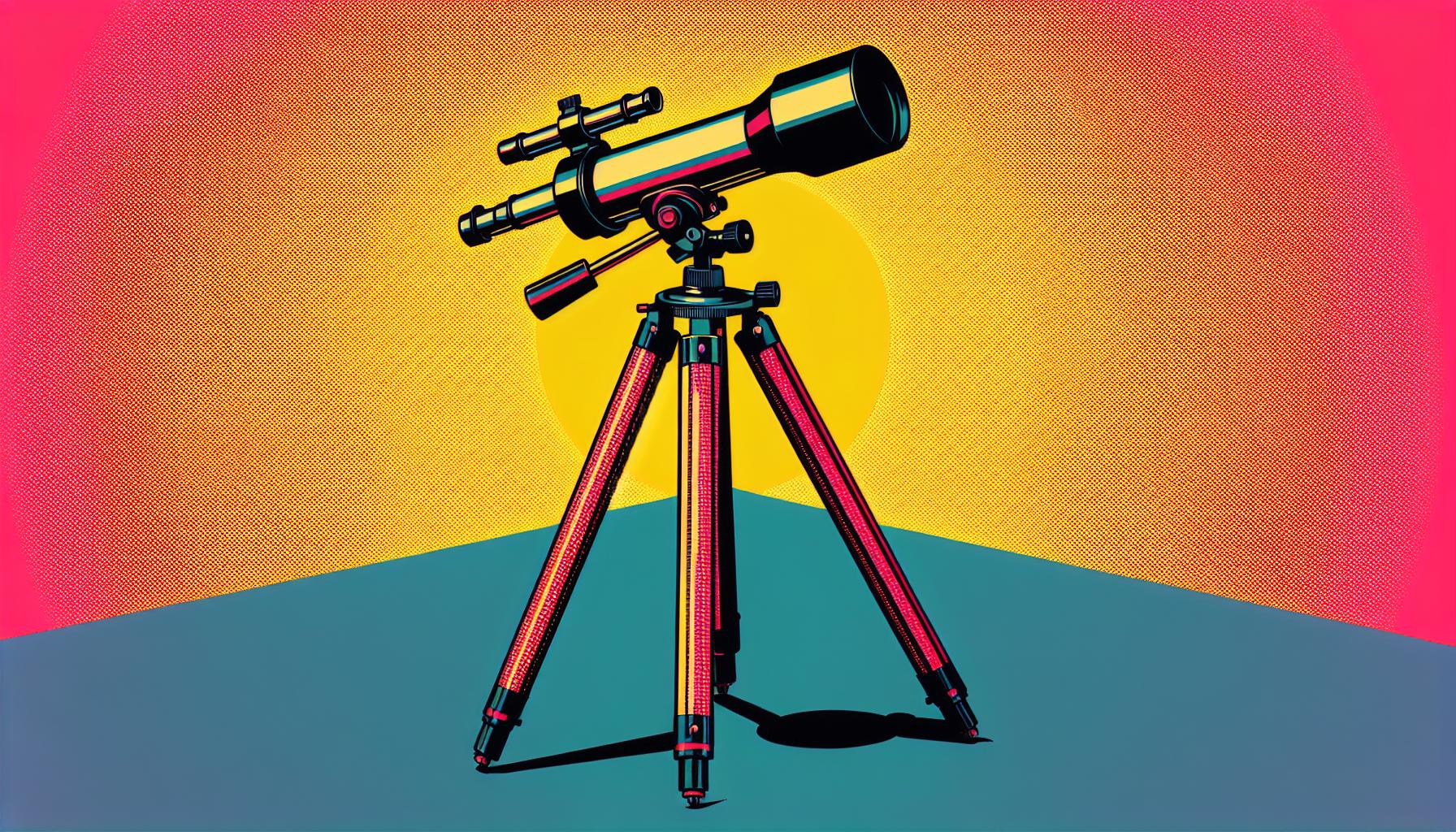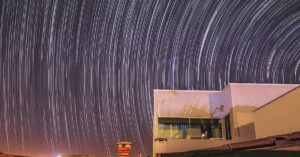This site contains affiliate links to products. I may receive a commission for purchases made through these links.
So you’ve got your hands on a fantastic telescope, but there’s a hitch – you don’t have a tripod. Don’t fret! I’m here to help you build your own.
Making a tripod for your telescope isn’t as daunting as it might seem. With a bit of creativity, some basic tools, and my step-by-step guide, you’ll have a sturdy, custom-made tripod in no time.
Trust me, there’s nothing quite like stargazing with a telescope that’s propped up on a tripod you crafted yourself. So, let’s dive right in and get started on this fun DIY project.
Materials needed to build your telescope tripod
Before jumping into the process, let’s discuss the materials required. Gathering everything before starting will not just help you stay organized, but also save time and avoid interruptions once you’re immersed in the project’s flow.
PVC Pipes: Durable and versatile, PVC pipe will serve as the crux of your tripod. You’ll need three pieces cut to your desired length for the legs, plus a slightly shorter one for the mount.
3-Way PVC Corner Fittings: Bolstering your tripod’s stability, these essential fittings will connect the PVC pipe legs to the mount.
Paracord/Cable Ties: A vital component in tenacity, paracord or cable ties will provide much-needed tension and prevent your tripod from collapsing.
Plywood: For the mount, we’ll attach a piece of plywood to the top of the PVC structure. It’s best to use a piece big enough to securely hold your telescope.
Sand/Water: A practical method to enhance stability, adding sand or water inside the PVC pipe legs can prevent your tripod from tipping.
Screws, Screwdriver, and Drill: Secure your telescope mount to the PVC pipes with screws.
The following markdown table presents these essentials visually. Take a moment to review, or perhaps even print this out, to have as a reference while you gather your supplies.
| Material | Quantity |
|---|---|
| PVC Pipe | 4 pieces |
| 3-Way PVC Corner Fittings | 1 piece |
| Paracord/Cable Ties | Depends on length of Pipe |
| Plywood | 1 piece |
| Sand/Water | As needed |
| Screws, Screwdriver, Drill | As needed |
When choosing materials, remember that quality counts. Higher-quality materials make for a more robust and stable tripod that will stand up against not just the weight of your telescope, but also the test of time. Once you’ve assembled everything, you’re ready for the next part, building the frame. This is where you’ll begin getting your hands dirty; but don’t worry, I’ll guide you with ease through the steps.
Step 1: Gather the tools
Kick-starting any project requires accurate and detailed planning. In this case, it’s essential to ensure we have all the necessary tools at hand. So, what will you need? Below’s a comprehensive list of items needed for our DIY telescope tripod build:
- Utility knife or handsaw
- Screwdriver
- Drill
- Drill bits
- Measuring tape
- Level
- Sandpaper
These are standard tools found in any well-equipped toolbox. If they’re not part of your collection, you can find them at any local hardware store or order conveniently online.
Keep in mind that tools should be used efficiently and safely. Therefore, it’s crucial to be aware of the safety measures associated with any tool use. This includes wearing protective gear, like gloves and goggles, to protect yourself from any possible accidents while working.
It’s also vital that the tools are in good condition. The utility knife or handsaw should be sharp enough to cut through PVC pipes. The drill should be powerful enough to penetrate plywood. The measuring tape needs to be accurate and in good working condition.
This is simply a preparation stage, where we gather all the necessary items for our handy telescope stand. Getting ourselves organized will allow us to focus on the task at hand and work without interruptions. Once we’re set with everything, we’ll smoothly transition into crafting our DIY telescope tripod using these tools. The next step involves constructing the frame, so stay tuned.
Step 2: Measure and cut the legs
Now that we’ve got all our essential tools ready, it’s time to jump into the main task. Setting the correct measurements for the legs of your DIY telescope tripod is the fundamental step before proceeding with cutting.
First off, you’ll need to decide the desired height for your telescope tripod. This completely depends on personal preference. You might prefer a tall tripod for viewing celestial bodies at a higher altitude. Or maybe a shorter one suits you better if you are more comfortable observing while seated.
Once you’ve fixed the height, mark that measurement on your chosen wood or metal pipe. Make sure you’re marking from one end. Accuracy is crucial here as uneven legs will affect the stability of your tripod.
Now comes the task of cutting. Using the utility knife or handsaw that we gathered earlier, carefully cut along the marked lines. Ensure each leg is cut at the same length, as consistency is key to an even and stable tripod. After cutting, use your sandpaper to smooth the edges. You wouldn’t want to get a splinter while adjusting your telescope, would you?
As a tip, if you’ve decided upon a taller tripod, let’s say 5 feet, be sure to cut a bit more, perhaps an inch extra. This allows some flexibility for future adjustments and improvements. After all, it’s easier to make it shorter when needed than to regret cutting it too short.
Next, you’ll want to cross-check all three legs for consistency. Measure them again to ensure they are of the same length. If not, a little more trimming may be necessary.
Here, check out the master tip for this step: Always measure twice, and cut once! This simple mantra will save you from any unnecessary mistakes and make this DIY project much smoother.
When we are satisfied with our masterfully cut tripod legs, we’ll dive into constructing the frame in our next step.
Step 3: Create the tripod head
Now that we’ve measured and cut our tripod legs to the desired length, let’s move along to the next phase. It’s time to take our DIY telescope tripod further by constructing the tripod head. This is a pivotal part of our tripod since it’s where our telescope will sit and swivel. A well-built tripod head provides the foundation for steady and precise viewing.
Building the tripod head begins with distinctly identifying the type of head you want to create. We have two types to choose from: the pan-tilt head and the ball head. Whichever you choose will depend on your preferences and what kind of telescope you’re using.
The Pan-Tilt Head is most common and ideal for beginners. It’s simple to design and operate, controlling movements in two directions, pans (left or right) and tilts (up or down).
The Ball Head, on the other hand, lets you move the telescope in any direction freely. It functions like a ball and socket, providing multiple axes of rotation. However, it’s slightly more complex to build and might require additional material, like a spherical bearing.
Take some time to decide on the type of head you want for your tripod. After making the choice, gather all the necessary materials. The materials will typically include a flat piece of metal or wood and some screws depending on the type of head.
Mark out the diameter of your telescope on the flat piece of material you chose. Cut out this circle with a precise hand, and make sure there are no rough edges that could damage your telescope.
From here, it’s right back to our key mantra: measure twice and cut once. Take this rule to heart and you’ll be confident in your cuts and measurements. These precautions will see your DIY telescope tripod taking form efficiently and smoothly. Stay tuned as we continue with the next steps.
Step 4: Attach the legs to the tripod head
Now that we’ve chosen our tripod head and meticulously crafted it to hold our telescope, it’s time to marry the tripod legs to the head. This step is critical as it’s what provides stability to our DIY telescope tripod.
Initially, we need to securely attach each leg to the tripod head. Depending on the design of your head and leg material, you’ll use different ways to do this. It could involve using screws and nuts, or even some sort of clamping contraption. The purpose here is to make sure the connection between the head and legs is solid and unshakeable.
Following the fixation of the legs to the head, we need to ensure the legs are spread out to form an evenly balanced tripod. If you were to draw lines to connect the tops of all three legs, it should form an equilateral triangle. This geometric property ensures even weight distribution and optimal stability.
Having now attached the legs to the head, we’ve taken a significant step forward in achieving our DIY telescope tripod. However, to keep information digestible, it’s critical to break down complex tasks. We’ll progress to our next important step in the following section.
Step 5: Test and adjust
Once the legs are securely attached, we’re right at the precipice of turning a bunch of separate pieces into a firm, trustworthy telescope tripod. But, there’s a little more to it. Having completed the arduous task of attaching each leg properly, we’ve stepped into the realm of testing and adjusting.
Find a flat surface to place your DIY telescope tripod on. Start spreading out the legs to form an equilateral triangle. The stability of your telescope is of utmost importance, remember, that’s the main purpose of the tripod. Equally distribute the weight of the telescope through each leg by adjusting them accordingly.
Next, place your telescope on the DIY tripod. Look out for any imbalance or wobbling. It could be minor and just need a small adjustment, or it might require you to go back and secure a leg more firmly.
Invest quality time in making these tiny adjustments; they’re important. They might seem tiresome and even frustrating, at times. But trust me, a shaky telescope will provide a hazy view, leading to a lackluster night of stargazing. In comparison, a well-adjusted, balanced DIY telescope tripod can enhance your stargazing experience tenfold.
Anticipate to go back and forth a few times between testing and adjusting. Don’t get disheartened as the process can be somewhat of a trial and error. Make sure each leg is spread out properly, and the telescope is balanced just right before moving forward.
Conclusion
So there you have it! I’ve walked you through crafting your own DIY telescope tripod. Remember, it’s all about balance and stability. Finding a flat surface and spreading out the legs evenly is key. Don’t be afraid to make small tweaks to get the balance just right. It might take a bit of time and patience, but it’s well worth the effort. Once you’ve nailed it, you’ll have a sturdy tripod that’ll enhance your stargazing adventures.
So go ahead, give it a shot! You’ll not only save money, but you’ll also gain a sense of accomplishment from creating something with your own hands. Trust me, the stars will seem even more magical when viewed from a tripod you’ve built yourself. Happy stargazing!
FAQ
What is the first step in building a DIY telescope tripod?
The first step is to measure and cut the legs of the tripod. Ensure they are of equal length to maintain balance.
Where should the tripod be placed for testing?
The tripod should be placed on a flat surface to test its stability. This will help to highlight any instability issues.
How should the legs of the tripod be positioned?
The legs of the tripod should be spread out to form an equilateral triangle. This distributes the weight evenly and enhances stability.
How important is the stability of the telescope?
The stability of the telescope is crucial. A secure and stable telescope will greatly enhance the stargazing experience and the quality of your observations.
Is it okay to make adjustments to the tripod?
Yes, making small adjustments to harmonize the tripod’s balance is not only okay, but also encouraged. This process might require some trial and error, but it is essential to perfect your DIY telescope tripod.
You may also like:




